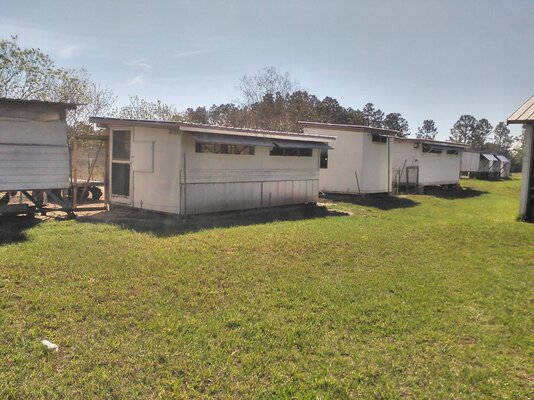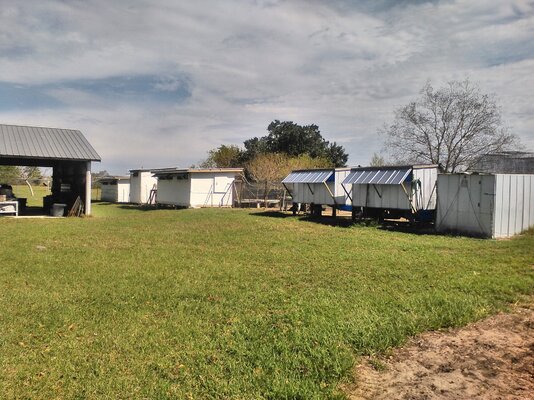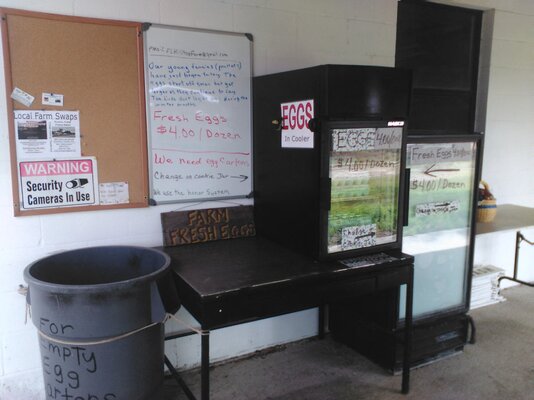Kimi BK
Songster
We are new to breeding, and new to owning roos, but have had chickens for a dozen years.
We now have 12 cockerels (Australorp, Wyandotte, and Welsummer) and 12 pullets (same, plus Easter Egger), all 16 weeks old. The pullets are in a 7'x16' pen with an enclosed upper portion ~7'x7', plenty of roosts, and plenty of next boxes. They have a 40'x40' yard protected by electric fencing and are only closed into the pen at night. This first pic is the coop & pen we currently use for our 12 pullets -- we had 24 juveniles in here until ~12 weeks when we separated out our cockerels.

Right now the cockerels are housed in a 20'x30' hoop house over our summer garden area. They have a table with 2 separate dog houses holding their roosts. The hoop house is screened in, and surrounded by electric fence. This is a temporary home. We will be harvesting them down to 3 roosters (one of each breed) which we can start at any time (honestly we are dragging our feet for that first kill and so far they seem happy so we haven't been pushed into culling... ).
).

Here are our goals as we inch toward breeding:
We now have 12 cockerels (Australorp, Wyandotte, and Welsummer) and 12 pullets (same, plus Easter Egger), all 16 weeks old. The pullets are in a 7'x16' pen with an enclosed upper portion ~7'x7', plenty of roosts, and plenty of next boxes. They have a 40'x40' yard protected by electric fencing and are only closed into the pen at night. This first pic is the coop & pen we currently use for our 12 pullets -- we had 24 juveniles in here until ~12 weeks when we separated out our cockerels.
Right now the cockerels are housed in a 20'x30' hoop house over our summer garden area. They have a table with 2 separate dog houses holding their roosts. The hoop house is screened in, and surrounded by electric fence. This is a temporary home. We will be harvesting them down to 3 roosters (one of each breed) which we can start at any time (honestly we are dragging our feet for that first kill and so far they seem happy so we haven't been pushed into culling...
 ).
).Here are our goals as we inch toward breeding:
- produce unfertilized eggs for eating & selling
- raise chicklets to get more layers and dinner roos (we'd be eating roos, but not selling meat)
- we are happy to eat any kind of roo
- we want our laying hens to be true breeds, or Easter-Egger / Welsummer mutts to possibly end up with a few olive eggers
- laying pen -- coop / pen / run for all our bachlorette production layers
- small roo pad for 3 stud roos (like ~4x8 pen with ~3x4 roost box and access to yard, or larger pen that they stay in)
- brood coop -- we'd plan to breed one breed at a time. We'd use those eggs for our own eating until we're pretty sure they're all fertile, then collect eggs until we have as many as we want to hatch, then eat them again until we're pretty sure they're non-fertile, then put the hens back into the laying pen, and use the brood coop to grow out the chicks once they are ready for the outdoors. (If we have a broody we'd try to let her raise the chicks.)
- when the new generation grows up we'd move the pullets in with the layers and harvest the roos
- eventually we hope we'll have enough layers and strong enough market to require a bigger layer coop than we currently have, so our current coop could end up being the brood coop. But we don't want to go and build a huge layer coop yet until we feel like this is a viable plan. So maybe our first house-raised chicks would go into a temporary hoop-house improvised coop or something like our current roos have done.
- we have a 4-season greenhouse where we could keep babies for the first 6 weeks if/when needed (we got our current crew of day-old chicks mid-October)
- does our plan above seem viable?
- it seems like most threads I've found about breeding have roosters staying with hens -- do most folks on here want fertilized eggs for eating, or not care either way and just want the benefits of a roo cohabitating?
- Do most of you who breed raise a lot more chicks than you need for eating & replacing layers? Are folks breeding to sell chicks / pullets?
- if we do the above, should we have the roo yard and hen yard adjacent (for predator warning etc)? Or would it be better to visually separate (so they don't drive each other crazy)? Right now our roos are housed visually separate from the hens, but they can hear each other. I do see the hens freeze sometimes when the roos call, and sometimes it seems like a roo's call causes the girls to scurry inside (unless it's just my imagination).
- if we try the above (separate brood pen with one breed at a time), would we only do one breeding per year? or would we have time for more than one? If we're raising the new generation in the brood coop, they'd probably need it for 4-5 months. I just don't know how seasonal breeding is, or if it is at all.
- Do you try to track which hens each egg came out of? It would seem to make sense, at least if planning on keeping one of the roos for future mating...?
- is there any sort of "breeding 101" thread I missed in my search?









